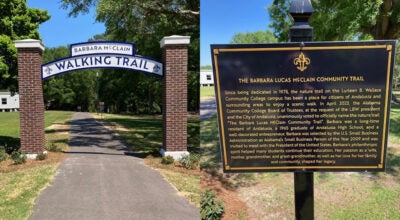East to west: Sidewalks come in 1920s
Published 11:43 am Saturday, April 23, 2016
“East side, West side, all around the town…” In the early 1920’s, the first sidewalks of Andalusia were built. When we used to roller skate in front of Mrs. Nanny Belle Waits house in the 1950’s, there was an imprint in the sidewalk that read “Tuscaloosa Concrete and Supply Co. 1914.” In addition to counting and avoiding all the cracks, my friends and I would kind of jump over that rough stamped area. Another imprint exactly the same that still remains is located in front of The First Presbyterian Church. There may be others along South Three Notch, East Three Notch, River Falls, and Church Streets – maybe even South Cotton and the Riley-Rankin Streets.
According to the late Mr. Allen Smyly, children who lived on the west side of town, down Church Street and River Falls Street, would walk to East Three Notch School passing right through the middle of the old courthouse which was located in the middle of the Public Square. Before a school cafeteria was added, town children would walk home for lunch and then return to school for afternoon classes. The late Berta McArtan Cook told me once, “It was my bad fortune to live right across from the school on Sixth Avenue, because I just walked across the street for lunch and all of my friends got to walk home a much longer way, and they always had so much fun on the way!”
What I have envisioned as I have read accounts of the early Public Square includes a lot of mud and boardwalks around what has been described as a cowboy-style town with saloons that hung out large banners listing the prices of whiskey. The mention of a few shootouts, whether legend or fact, are also a part of our downtown history! It only makes sense that these occurrences surely resulted in the founding and establishment of the churches in the New Site or the town later called Andalusia. Whether it was ever named New Site or not, we don’t really know, but the spot was shown as New Site on some older Alabama maps. Maybe that was before the name Andalusia was finally decided on by the settlers who moved up the hill from Montezuma.
Horse and buggies as well as mule and wagons made their way along the dirt streets, but by about 1918-1919 when the automobiles began to arrive in number, street paving became a necessity if a village wanted to grow and become a town.
There used to be a man who walked the sidewalks at night. This was in the early 1960’s. When my neighborhood friends Marge Russell and Betty Radcliff or myself were hosting Friday night spend-the-night parties, with lights out we would all gather around the open windows around midnight to watch for this character to walk around the big curve on East Three Notch headed toward town. There was a street light that lit his path. When we saw his shadow coming, we would all scream, “Here he comes!” Our mothers, of course, would have to get out of bed and come quiet us down. I guess that was Andalusia’s Boo Radley! To my knowledge no one ever knew why he was a night walker!
When my brother Tripp Bass, a grade schooler, would arrive home around 3:00 in the afternoons, his dog Teddy would be waiting in the driveway for him. Tripp would crank up the go-cart and Teddy would jump on ready for his daily ride up the sidewalks on East Three Notch! This was in the early 1970’s.
The February 26, 1922 edition of The Birmingham News features a full page article on our town, “Andalusia Is a Wonderful Place To Live And To Make a Living.” An excerpt reads, “The city has three miles of excellent paving, sanitary sewers, and ten miles of concreted sidewalks.”
Thus, Andalusia finally had sidewalks for children to write chalk on for hopscotch AND when they got to school, their bare feet or shoes were a lot cleaner than before the dirt pathways they previously followed! I’ll bet there were a lot more Sunday afternoon strolls, too, down the streets with the picket fences and around the square especially with the ladies showing off their fashionable hats of the day! I’m certain that the boys on the bicycles delivering the Western Union telegrams enjoyed the newly paved sidewalks!
Some of the “sidewalk neighborhoods” are still described as such in real estate ads. Most of those homes built on the fifty-foot wide lots boasted front porches where the residents would often sit after supper listening to their radios sounding from their living rooms and say “How do you do?” to the passers-by walking along the sidewalks. However, as one old-timer stated, “Things changed when people quit sitting on the porches!”


